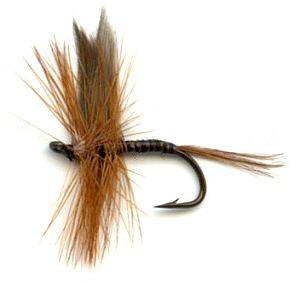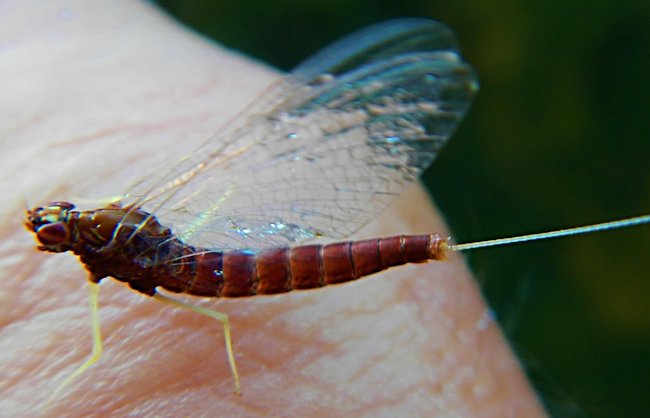The Red Quill Dry Fly
Red Quill fly fishing dry flies represent the two different insects that are commonly given the same name: the March Brown (Rithrogena Germanica) and the Late (or False) March Brown (Ecdyonurius Venosus). Look for hatches of the March Brown in the late spring just after lunch time.

DRY FLY PATTERNS. Hook size 12 14 16 - $US each
The Late March Browns hatch in early summer after the March Brown hatch. Some years may bring a late season hatch if there is hot weather. It is the emerging nymphs of this mayfly that are regularly eaten by trout, but duns and egg laying female spinners are also taken. Spinner typically ride the water with their wings upright at first, then semi-spent, or held at half mast, after which their energy is exhausted and they collapse onto the water in the spent position, with their wings flat in the film. Trout might take them in any of the three positions, but most are taken spent, which is the position that is most difficult for an angler to detect.

When I spot rising trout upstream and off to the side from my position, feasting on March Brown mayfly duns, I use an upstream and across cast to place the fly in the trout’s line of sight with a carefully delivered drift whilst keeping the leader and tippet off to the side. You have to learn how far upstream to place your cast so as not to spook the fish, by experimentation. I always start with a longer cast first and watch how the current takes my Red Quill dry fly.
What you do not want to happen is for your fly to drag and produce an unnatural disturbance on the water. This does not happen to adult duns that have just hatched and are waiting for their wings to harden before flying off. The waiting trout will see what is happening to your artificial fly and move away. When casting across currents of different speeds, the fly’s drift is often very short before it drags, so you will have to place the fly closer to the trout’s holding position.
On stretches of water that have a consistent flow, then the clarity of the water and the wariness of the trout due to fishing pressure, will dictate where you can place your Red Quill fly. On more popular waters that are regularly fished you will have to make longer casts and drifts to your target. The trout will let you know what is acceptable. There is no hard and fast rule. The distance varies from location to location. Always let your fly drift three or more feet past the trout before picking up for another cast so as not to scare them away
If you spot fish rising to a hatch of March Browns downstream from your position try to position the line as far away from the fish’s line of sight as you can and let the leader and tippet drift slowly into the feeding zone. After the fly has drifted past without a take move the rod tip away from the fish. This will make the fly line swing out of the trout’s window of vision. Then quickly pick up the line for another cast. It is always harder to set the hook when fishing downstream. Be prepared to raise the rod tip and always monitor the amount of slack you have on your line. Too much slack and you will fail to hook your fish, too little slack will cause drag and spook the trout. Experience is the best teacher. You will soon find what works. Be vigilant all the time, but remember to have fun.
Egg laying female Large Dark Olives are known as red spinners
The Red Quill Dry Fly pattern is a strangly a great imitation of a female egg laying Large Dark Olive Spinner. I often go for weeks to the Welsh borders and fish trout streams such as the Teme, Clun, Onny and Lugg. Since effective trout fishing on these waters begins at least six weeks earlier than it does on most southern chalkstreams this was the place to go to satisfy the flyfishing itch I get during periods of bad winter weather, when you cannot get on the water. It is where I renew my acquaintance with an old friend, the large dark olive mayfly that has the Latin family name of Baetis Rhodani.
This mayfly is not absent or less prolific on the chalkstreams. It is as abundant in the southern downland valley streams and rivers as anywhere else. Down south it’s hatching periods, from mid-March until late April and then from mid-September to late October, are either over by the time chalkstream trout come into worthwhile feeding mettle or coincide with the end of the trout fishing season.
I find on the rougher streams of the Welsh Marches, where the large dark olive mayfly, when it hatches even in only sporadic numbers, encourages much more interest in the trout than what I find happens on chalkstream rivers. I do not know why this is so but I guess that it has something to do with an earlier acclimatisation of the trout on those spate rivers, and their readiness to begin feeding close to the surface weeks earlier than their southern cousins.
More trout are taken in the early part of the season because these rivers lend themselves to the wet fly method of fishing better than the chalkstreams. The trout seem to be more ready to take a wet fly than they are a dry fly. Who knows? This is all conjecture. What I know from experience is that the large dark olive mayfly is the most important up-winged fly to emerge during the first weeks of the trout fishing season in this part of the United Kingdom.
It is the largest British mayfly in the group of flies known as olives (from the genus Baetis). Other members of the same family group are the medium olives, pale watery olives, small dark olive, spurwing olives and the iron blue dun. They are all a lot smaller than the large dark olive mayfly and hatch much later in the season.
Fly fishermen walking the banks early in the year will be familiar with the fly, as it often adds interest to what might otherwise be a barren period in terms of wildlife. The large dark olive is unmistakable. It is a large robust dun about the size of a March brown, another early-season mayfly whose habitat regularly coincides with that of the olive. There the likeness ends, for the large dark olive’s colour immediately separates it from the March brown.
The large dark olive’s body colour varies between dark olive-brown to medium olive-green. These variations have been attributed to the differences in air temperature when hatches occur according to some observers. Goddard suggested that the flies of late spring are paler than their counterparts of a month or so earlier. Some books state that the larger female dun’s body is paler than the males. I cannot see a difference.
The wings of the newly hatched large dark olive mayfly dun are a deep ash-grey colour. They are by far the most distinctive feature of the fly. As they are held upright they make the insect particularly visible even on the darkest days of early spring.
The large dark olive has a habit of holding its wings close together which serves to suggest a darker wing colour than in fact they have. This impression is heightened in the male dun as the wing veining appears more prominently pale brown. The wings stand proud of the body at least 10mm or so tall.
The adult dun’s body is about 12-14mm long. Like all olives it has long two tails which contrasts with the three tails it has as a nymph. The six legs of both the male and the female are slightly paler than the rest of the body and serve to emphasise the general darker colour of the body segments.
Spinners are less important to the fly fisherman than the large dark olive dun because the return of the female to the water for egg-lying takes place over an extended period during the day, not in concentrations normally associated with the fall of spinners of other mayfly species.
The female crawls beneath the surface to lay her eggs. Having completed the egg-laying she does not die, but floats to the surface, where she often becomes entrapped in the water surface tension, making her vulnerable to patrolling hungry trout. Known as the red spinner, her body is a deep red-brown with fading orange-brown to the last three segments. The legs are a pale brown-olive.
Rises to the large dark olive mayfly take place during the warmer parts of the day and are normally confined to the emergence of duns. However I have taken occasional trout on warmer early evenings in late April by watching the fish feeding on the surface, ensnaring female spinners as they recover from egg-laying. These opportunities often occur along banks, footbridge pillars or boat pier posts.
I find an olive Gold Ribbed Hare’s Ear nymph hook size 12 is the best large dark olive mayfly nymph pattern to use. If you are going to fish with a team of three flies I would recommend putting a beaded olive Gold Ribbed Hare’s Ear nymph on the point, a normal olive Gold Ribbed Hare’s Ear nymph in the middle and a Red Quill on the top.
LEARN TO READ THE RIVER TO CATCH TROUT
Have a look at the photograph below. Where do you think the best place would be
to find hungry lurking trout? The river is flowing from bottom left to top
right. Can you see those ripples on the water just at the end of that clump of
vegetation? That is the water "crease". This is where an area of faster flowing
water meets a slower section of water. The aquatic plants are a barrier. This is
the sort of location favored by adult trout. They do not have to constantly swim
against a strong current. They can rest behind the weed clump, downstream from
the water flow, and let nymphs and insects trapped in the water surface float
past them. When they see something they like they can quickly move to intercept
it. Your tactics should be to cast upstream of the vegetation and let you
artificial fly pattern float past the trout's lair. To get their attention you
could try a little tweak on the line to add movement to your fly as it passes
the last clump of grass.

If you look after sections of streams or rivers you should encourage the growth of aquatic weeds and grass like this. Flag Iris plants are very useful as well in providing an ideal habitat for the local fish population. Not only do they provide a good hunting location for adult trout but they also make a great environment for young fish to find food and shelter from larger predators.
CUSTOMER'S COMMENT
What a great evening on the water ! Caught the last of the hatch and scored a beauty on a size 14 red quill. And then hit the spinner fall and picked up one more that was just a piggy. Tim Day, PA, USA


Fly Fishing books

